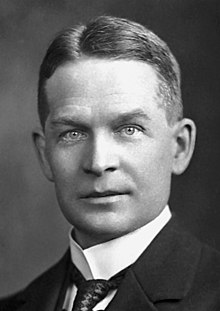Frederick Soddy
Frederick Soddy (born September 2, 1877 in Eastbourne , † September 22, 1956 in Brighton ) was an English chemist in the field of radiochemistry .
Soddy was a student of Ernest Rutherford . In 1921 he was awarded the Nobel Prize in Chemistry .
Live and act
Frederick Soddy studied chemistry at the College of Wales at Aberystwyth and the University of Oxford . There he worked from 1898 to 1900. He then carried out research on radioactivity with Rutherford at McGill University in Montreal (Canada) . In 1903, together with Sir William Ramsay , he demonstrated that the alpha decay of radium produced helium .
From 1904 to 1914 he taught at the University of Glasgow . During this time he was able to show that atoms of radioactive elements can have different masses but the same chemical properties. In 1913 he coined the term isotope for it ; later it turned out that stable elements can also consist of several isotopes. In 1914 Soddy moved to Aberdeen University , and in 1919 back to Oxford until 1936.
Soddy received the Nobel Prize in Chemistry in 1921 "for his contributions to the knowledge of the chemistry of radioactive substances and his investigations into the occurrence and nature of isotopes". In 1922 the newly discovered mineral soddyite was named after him.
In 1908 Soddy held a public series of lectures on the state of knowledge of radioactivity at the time, which was also recorded in book form ( The Interpretation of Radium , German: The nature of radium ). This book inspired HG Wells to write his novel The World Set Free ( Liberated world ).
In 1936 Frederick Soddy rediscovered Descartes' theorem . Hence, René Descartes ' circles are sometimes referred to as the Soddy circles , perhaps also because Soddy published his version of the sentence in the form of a poem called The Kiss Precise , which was reprinted in Nature .
Since 1910 he was a Fellow of the Royal Society . In 1924 he was accepted as a corresponding member of the Russian Academy of Sciences .
Economy, banking system
In the 1920s and 1930s he also dealt with some topics related to the banking system and the economy . He asked himself why the natural sciences and technologies have made such advances, but why these advances were then used primarily in war and also experienced a particular boost in war. He investigated the question of why there are always wars and came across a connection to the banking system. In his book "Wealth, Virtual Wealth and Debt" he pointed out three main problems:
- the problem of deposit money and above all the money creation of commercial banks ,
- the problems of the interest rate system and the associated debt obligation and
- the problem of money creation in the hands of private central banks (such as the FED founded in 1913 ).
anti-Semitism
In Wealth, Virtual Wealth and Debt , published 1926, Soddy cited the, falsified, Protocols of the Elders of Zion as evidence of the then relatively widespread belief in a "financial conspiracy to enslave the world ". He used images of a Jewish conspiracy to back up his claim that "a corrupt monetary system is attacking the life of the nation". He also refers to “the semi-oriental” who is “the highest” in “high finances” and to a “shimmering bubble of convictions blown around the world by the Hebrew hierarchy”. In later life, in 1939, he published his pamphlet, Abolish Private Money, or Drown in Debt, with a well-known anti-Semitic publisher in New York.
Fonts (selection)
- The Interpretation of Radium. J. Murray, London 1909 ( digitized version )
- Wealth, Virtual Wealth and Debt. Allen & Unwin, London 1926.
- The role of money. George Routledge & Sons, London 1934 ( Text Archive - Internet Archive ).
See also
literature
Books
- Muriel Howorth: Pioneer Research on the Atom: Rutherford and Soddy in a Glorious Chapter of Science. The Life Story of Frederick Soddy, MA, LL.D., FRS, Nobel Laureate . New World Publications, 1958.
- Thaddeus J. Trenn: The self-splitting atom: The history of the Rutherford-Soddy collaboration . Taylor & Francis, London 1977, ISBN 0-85066-109-9 .
Magazines
- Claude Million: Frederic Soddy and the Physics of Getting into Debt. In: Zeitschrift für Sozialökonomie , No. 151, December 2006, pp. 31–36 ( Sozialoekonomie-online.de ).
- Mansel Davies: Frederick Soddy: The scientist as prophet . In: Annals of Science , Volume 49, Number 4, 1992, pp. 351-367 ( doi: 10.1080 / 00033799200200301 ).
- Richard E. Sclove: Alchemy to Atomic War: Frederick Soddy's “Technology Assessment” of Atomic Energy, 1900-1915 . In: Science Technology Human Values , Volume 14, Number 2, 1989, pp. 163-194 ( doi: 10.1177 / 016224398901400203 ).
Others
- Frederick Soddy: The origins of the conceptions of isotopes (PDF) Nobel Lecture, December 12, 1922 (Nobel Prize Lecture)
Web links
- Literature by and about Frederick Soddy in the catalog of the German National Library
- Information from the Nobel Foundation on the award ceremony for Frederick Soddy in 1921
- Eric Zencey: Mr. Soddy's Ecological Economy . In: New York Times , April 11, 2009; about Soddy's economic ideas
- Entry on Soddy, Frederick (1877–1956) in the Archives of the Royal Society , London
Individual evidence
- ↑ Nature , June 20, 1936
- ↑ John F. Ptak: Frederick Soddy's Economics and the Protocols of the Elders of Zion (1939 ) on the blog of a US bookseller ( JF Ptak Science Books )
| personal data | |
|---|---|
| SURNAME | Soddy, Frederick |
| BRIEF DESCRIPTION | English chemist |
| DATE OF BIRTH | September 2, 1877 |
| PLACE OF BIRTH | Eastbourne |
| DATE OF DEATH | September 22, 1956 |
| Place of death | Brighton , England |

